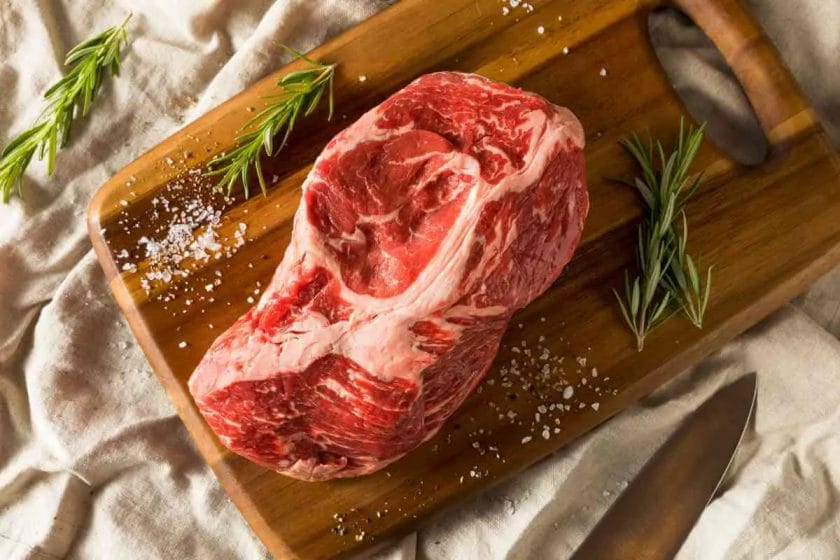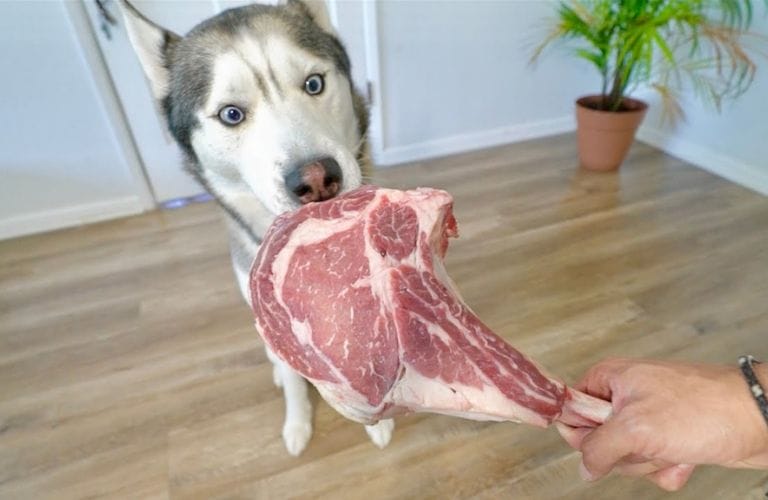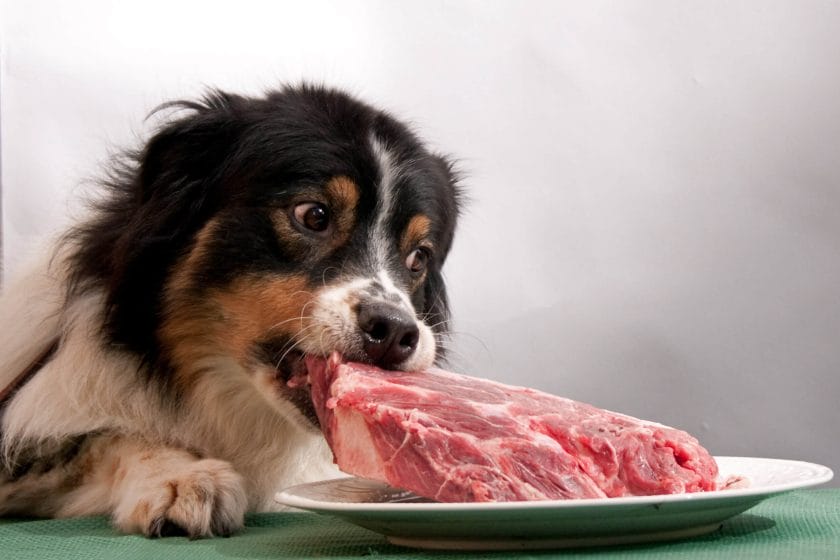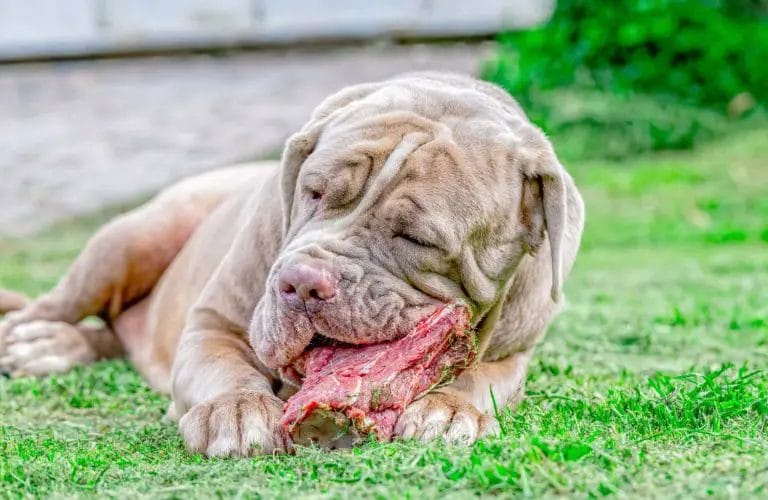If you’re wondering whether dogs can eat the fat from steak, the answer is, it depends. While some fat can be beneficial for dogs, excess fat can lead to digestive issues and weight gain.
It’s important to remove any large chunks of fat before offering it to your furry friend. Additionally, remember to feed in moderation and consult with your veterinarian to ensure a healthy and balanced diet for your pup.

Can Dogs Safely Consume the Fat from Steak?
Many dog owners enjoy sharing their favorite foods with their furry companions. However, it’s crucial to consider whether certain foods are safe for dogs to consume. One such food is the fat from steak.
Steak fat, also known as trimmings or drippings, is often left over after cooking a delicious steak. While it may be tempting to toss a piece of fat to your dog as a treat, it’s essential to understand the potential risks involved.
When it comes to feeding dogs steak fat, moderation is key. While a small amount of fat may not cause harm, excessive consumption can lead to various health issues. Here are a few factors to consider:
Potential Benefits of Steak Fat for Dogs
In small quantities, steak fat can provide some benefits to dogs:
- Source of energy: Fat is a concentrated source of calories, providing dogs with an additional energy boost.
- Enhanced palatability: The rich flavor and aroma of steak fat can make a meal more appealing to dogs.
- Healthy skin and coat: Adequate fat intake can contribute to a shiny coat and moisturized skin.
Potential Risks of Steak Fat for Dogs
While there are potential benefits, it’s crucial to be aware of the risks associated with feeding steak fat to dogs:
- Pancreatitis: Fatty foods can trigger pancreatitis, an inflammatory condition that affects the pancreas. Symptoms include vomiting, diarrhea, and abdominal pain.
- Obesity: Excessive fat consumption can lead to weight gain and obesity, which can have severe consequences on a dog’s overall health.
- Digestive issues: Dogs may experience gastrointestinal upset, such as diarrhea or constipation, when consuming high amounts of fat.
- Choking hazard: Large pieces of fat can pose a choking hazard to dogs, especially those who are prone to gobbling food quickly.
Guidelines for Feeding Steak Fat to Dogs
If you decide to give your dog steak fat as an occasional treat, it’s essential to follow these guidelines:
- Keep portions small: Limit the amount of steak fat given to your dog to avoid overloading their system with excessive fat.
- Trim off excess fat: Remove excess fat from the steak before cooking to reduce the fat content.
- Avoid seasoning: Ensure that the steak fat is plain and free from any seasoning, such as salt or spices, which can be harmful to dogs.
- Monitor for adverse reactions: Watch for any signs of digestive upset or discomfort after feeding your dog steak fat. If any issues arise, consult your veterinarian.
While dogs can consume small amounts of steak fat without immediate harm, it’s crucial to remember that excessive fat consumption can lead to various health problems.
As a responsible pet owner, it’s best to offer healthier treats specifically designed for dogs and consult with a veterinarian if you have any concerns about your dog’s diet.

Potential Health Risks of Feeding Dogs Steak Fat
Feeding your furry friend with tasty treats is a way to show them love and affection. However, it is important to be aware of the potential health risks associated with certain foods, including steak fat.
While dogs may find it delicious, consuming excessive amounts of steak fat can have negative impacts on their health. In this section, we will discuss some of the potential health risks that come with feeding dogs steak fat.
1. Obesity
One of the primary concerns of feeding dogs steak fat is the risk of obesity. Steak fat is high in calories and can quickly contribute to weight gain in dogs.
Just like in humans, obesity in dogs can lead to a range of health issues such as joint problems, heart disease, and diabetes. It is important to monitor your dog’s calorie intake and ensure they maintain a healthy weight.
2. Pancreatitis
Dogs have a different digestive system compared to humans, and feeding them fatty foods like steak fat can put them at risk of developing pancreatitis. Pancreatitis is the inflammation of the pancreas and can be painful and potentially life-threatening for dogs.
The high fat content in steak fat can trigger pancreatitis, causing symptoms such as abdominal pain, vomiting, and loss of appetite.
3. Gastrointestinal Upset
Feeding dogs steak fat can also lead to gastrointestinal upset. Dogs may experience diarrhea, vomiting, and stomach discomfort as their digestive system may struggle to break down and process the high-fat content.
These symptoms can be distressing for your pet and may require veterinary intervention to alleviate the discomfort.
4. Nutritional Imbalance
While dogs require a certain amount of fat in their diet, it is essential to provide them with high-quality, balanced nutrition. Feeding them excessive amounts of steak fat can disrupt the balance of their diet and lead to nutritional imbalances.
Dogs need a well-rounded diet that includes proteins, carbohydrates, fats, vitamins, and minerals. Feeding them too much steak fat can skew this balance and potentially cause deficiencies in other essential nutrients.
5. Choking Hazard
Steak fat, especially in larger chunks, can pose a choking hazard for dogs. If your furry friend’s excitement over a delicious treat leads them to swallow large pieces of steak fat without properly chewing, it can get lodged in their throat or cause other blockages in their digestive tract.
This can result in significant distress and may require immediate medical attention.
How to Properly Introduce Steak Fat into a Dog’s Diet
Feeding your furry friend a balanced and nutritious diet is essential for their overall health and well-being. While it’s important to provide them with the right amount of protein, carbohydrates, and essential nutrients, there is a common misconception about the inclusion of fat in a dog’s diet.
While excess fat can be harmful, moderate amounts of healthy fat can actually benefit your dog’s health. One such fat is steak fat, which can be a tasty and nutritious addition to their meals when introduced properly.
Benefits of Steak Fat in a Dog’s Diet
Steak fat, when given in moderation, can provide several benefits to your dog’s diet:
- Increased Energy: Fat is a concentrated source of energy, and adding a small amount of steak fat to your dog’s meals can give them an energy boost.
- Improved Coat and Skin: Healthy fats, such as those found in steak fat, can contribute to a shiny and healthy coat, as well as help alleviate dry skin.
- Nutrient Absorption: Certain vitamins, such as vitamins A, D, E, and K, are fat-soluble, meaning they need fat to be properly absorbed in the body. Including steak fat can enhance the absorption of these essential nutrients.
- Taste and Palatability: Let’s face it, dogs love the taste of fat! Adding a small amount of steak fat to their meals can make them more enticing, especially for picky eaters.
Important Considerations
While steak fat can be beneficial, it’s crucial to introduce it into your dog’s diet gradually and in the right way:
- Quality and Sourcing: Ensure that the steak fat you’re using is of high quality and sourced from a reputable supplier. Avoid using fat that has been heavily seasoned, as it may contain harmful additives.
- Portion Control: Moderation is key when it comes to adding steak fat. Start by introducing small amounts, such as a teaspoon, and observe how your dog responds. Adjust the portion accordingly to prevent any digestive upset.
- Balance with Other Nutrients: Remember that steak fat should be a supplement to your dog’s regular diet, not a replacement for a balanced meal. Make sure their meals still consist of a quality protein source, carbohydrates, and a variety of other nutrients.
- Monitoring Health and Weight: Keep an eye on your dog’s weight and overall health when introducing steak fat. If you notice any negative changes, such as weight gain or digestive issues, consult your veterinarian.
Methods of Introducing Steak Fat
There are different ways you can introduce steak fat into your dog’s diet:
- Mixing with Regular Food: Start by adding a small amount of finely chopped or melted steak fat to their regular meals. Gradually increase the portion size over time, while monitoring their response.
- Freezing as Treats: Pour melted steak fat into ice cube trays and freeze them. These fat cubes can serve as occasional treats that provide both taste and the benefits of healthy fats.
- Using as a Meal Topper: Drizzle a small amount of melted steak fat on top of your dog’s meal to enhance its flavor and make it more enticing.

Alternatives to feeding dogs the fat from steak
Feeding our dogs a well-balanced diet is essential for their overall health and well-being. While steak fat may seem like a tasty treat for our furry friends, it is important to understand that certain fats can be harmful to dogs and can lead to various health issues.
Instead of feeding dogs the fat from steak, here are some alternative options that can provide them with a nutritious and safe diet:
- Lean meats: Instead of giving your dog the fatty part of steak, opt for lean cuts of meat such as chicken, turkey, or fish. These meats are not only lower in fat but also high in protein, which is essential for your dog’s muscle development and overall health.
- Fruits and vegetables: Incorporating a variety of fruits and vegetables into your dog’s diet can provide them with essential vitamins, minerals, and fiber. Some dog-friendly options include carrots, green beans, sweet potatoes, and apples. However, it is important to avoid feeding them grapes, onions, or any toxic fruits or vegetables.
- Commercial dog food: High-quality commercial dog food brands offer a wide range of options specifically formulated to meet your dog’s nutritional needs. These foods are carefully balanced to provide the right amount of protein, carbohydrates, and fats. When choosing a commercial dog food, look for those with real meat as the first ingredient and without any artificial additives or fillers.
- Homemade dog food: If you prefer to have full control over your dog’s diet, you can consider preparing homemade meals for them. However, it is crucial to consult with a veterinarian or a canine nutritionist to ensure that you are providing a well-balanced diet that meets your dog’s specific requirements. Homemade meals should include a combination of lean meats, vegetables, whole grains, and essential supplements.
- Healthy treats: Instead of feeding your dog the fat from steak as a treat, there are numerous healthy alternatives available in the market. Look for treats that are specifically made for dogs and are low in fat and calories. You can also consider making homemade treats using ingredients like pumpkin, peanut butter, or oats, as long as they are safe for dogs.
Expert Opinions on Feeding Dogs Steak Fat
Feeding our furry friends can sometimes be a topic of debate, especially when it comes to sharing our own food with them. Many dog owners are guilty of slipping a piece of steak fat to their four-legged companions under the table. But is it safe?
In this section, we will explore the expert opinions on feeding dogs steak fat.
1. Veterinarians:
Veterinarians generally advise against feeding dogs steak fat, or any type of fat, as a regular part of their diet. While a small amount of fat may not immediately harm a dog, excessive consumption can lead to various health issues.
Fat is high in calories and can contribute to obesity and pancreatitis, a condition where the pancreas becomes inflamed. Pancreatitis can cause severe abdominal pain, diarrhea, and vomiting.
2. Nutritionists:
Nutritionists emphasize the importance of a balanced and controlled diet for dogs. They recommend feeding dogs a specific combination of proteins, fats, carbohydrates, vitamins, and minerals to meet their nutritional needs.
While fat is an essential component of a dog’s diet, it should come from high-quality sources specifically formulated for their needs. Steak fat may not provide the necessary nutrients and can upset the delicate balance of their diet.
3. Animal Behaviorists:
Animal behaviorists often focus on the impact of diet on a dog’s behavior. Feeding dogs fatty foods like steak fat can lead to gastrointestinal upset, such as diarrhea or constipation.
These digestive issues can not only be uncomfortable for the dog but can also affect their behavior and overall well-being. Dogs may become lethargic, irritable, or experience a lack of appetite.
4. Alternative Views:
While most experts advise against feeding dogs steak fat, some pet owners, trainers, or breeders may have a different perspective. They argue that in moderation, a small piece of steak fat can be a tasty treat for dogs.
They believe that as long as it is given sparingly and in appropriate portions, it may not cause any significant harm. However, it is crucial to remember that individual dogs may react differently to food, and what works for one may not work for another.

FAQs
Can dogs eat the fat from steak?
No, it is not recommended to feed dogs the fat from steak. While small amounts may not harm them, excessive fat consumption can lead to pancreatitis, obesity, and digestive issues. It’s best to remove the fat before giving steak to your dog.
How often should I brush my dog’s teeth?
It is recommended to brush your dog’s teeth at least 2-3 times a week to maintain good oral hygiene. Regular brushing helps prevent tartar buildup, gum disease, and bad breath. Use a dog-specific toothbrush and toothpaste approved by your veterinarian.
Can I give my dog human painkillers?
No, you should never give your dog human painkillers without consulting a veterinarian first.
Many human medications, including painkillers like ibuprofen or acetaminophen, can be toxic to dogs and cause severe health issues. Always seek professional advice for appropriate dog-specific pain relief options.
Conclusion
In conclusion, dogs can eat the fat from steak, but it should be given in moderation. While fat is a good source of energy for dogs, excessive consumption can lead to weight gain and other health issues. It is important to trim off any excess fat before offering it to your furry friend.
Additionally, it is vital to ensure the meat is cooked properly to avoid any potential bacterial contamination. Always consult with your veterinarian before introducing any new foods into your dog’s diet to ensure their overall health and well-being.
Remember, a balanced and nutritious diet is key to keeping your canine companion happy and healthy!
So, go ahead and treat your pup to a small piece of steak fat occasionally, but remember to prioritize their health and practice moderation. Your furry friend will appreciate the tasty treat, and with your careful consideration, they can enjoy it without any negative consequences.

